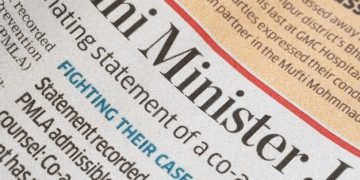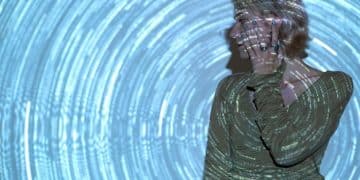Evaluating Scientific Study Credibility in News Articles

Anúncios
Evaluating the credibility of scientific studies cited in news articles involves scrutinizing methodology, peer review status, author affiliations, and potential biases to ensure the information is trustworthy and accurately represented.
Anúncios
In an era of information overload, evaluating the credibility of scientific studies cited in news articles is crucial to discerning facts from misinformation, ensuring we make informed decisions based on sound evidence.
Understanding the Importance of Scientific Credibility
Scientific studies often form the backbone of news stories, influencing public opinion and policy decisions. Therefore, understanding the importance of scientific credibility is paramount for informed citizenship.
Anúncios
When news outlets report on scientific findings, it is essential to critically evaluate the sources and methodologies to avoid misinterpretations or the spread of inaccurate information. This not only protects individuals from making poor choices but also ensures that societal policies are based on reliable data.
The Role of Peer Review
Peer review is a cornerstone of scientific integrity. It involves experts in the field scrutinizing a study’s methodology, results, and conclusions before publication.
Identifying Potential Biases
Bias can creep into scientific studies in many forms. It’s essential to identify these potential biases when evaluating the credibility of the study.
- Funding Sources: Who funded the study? Funding from vested interests can influence results.
- Author Affiliations: Are the authors affiliated with organizations that might benefit from certain outcomes?
- Publication Bias: Are only positive or significant results being published, while negative or inconclusive findings are ignored?
Ultimately, the importance of scientific credibility lies in its ability to guide understanding and decision-making processes. By employing critical evaluation techniques, readers can better assess the trustworthiness and reliability of scientific claims presented in the news.

Assessing Methodology and Study Design
The methodology and study design of a scientific study are critical components to assess its credibility. Understanding how a study was conducted can provide valuable insights into the reliability of its findings.
Different types of studies have different strengths and weaknesses. Randomized controlled trials (RCTs) are considered the gold standard, while observational studies can only show associations, not causation. Therefore, evaluating the methodology involves looking at the sample size, control groups, and data collection methods.
Sample Size and Statistical Power
A study’s sample size is important, indicating the number of participants or data points included. Larger sample sizes generally lead to more reliable results because they provide greater statistical power.
Control Groups and Blinding
Control groups are vital for comparing the effects of an intervention or treatment. Blinding, where participants and researchers are unaware of who belongs to the control or experimental group, helps to minimize bias.
- Randomization: Were participants randomly assigned to different groups?
- Blinding: Was the study blinded to prevent bias?
- Controls: Was there an appropriate control group for comparison?
In conclusion, assessing methodology and study design is essential for determining the credibility of scientific studies. By knowing what to look for in these elements, readers can be more discerning consumers of scientific news.
Examining Author Credentials and Conflicts of Interest
When evaluating the credibility of scientific studies cited in news articles, it’s important to examine the credentials of the authors and identify any potential conflicts of interest.
The expertise and affiliations of researchers can significantly impact the reliability of their findings. Conflicts of interest, whether financial or professional, may also influence the outcomes and interpretations of the study.
Verifying Expertise and Affiliations
Begin by researching the authors’ backgrounds. Look for their academic qualifications, professional experience, and affiliations with reputable institutions.
Identifying Conflicts of Interest
Conflicts of interest can arise when researchers have financial, professional, or personal interests that could compromise the integrity of their work.
- Financial Ties: Do the authors have financial ties to companies or industries related to their research?
- Professional Affiliations: Are the authors affiliated with organizations that have vested interests in the study’s results?
- Declaration Statements: Do the authors disclose any potential conflicts of interest in their published work?
In summary, a thorough examination of author credentials and potential conflicts of interest is essential for evaluating the credibility of scientific studies. By being vigilant and questioning motives, readers can better assess the reliability of scientific claims presented in the news.

Deciphering Statistical Significance and Effect Size
Statistical significance and effect size are key statistical concepts that help determine the credibility and practical importance of scientific study findings.
A statistically significant result indicates that the observed effect is unlikely to have occurred by chance. Effect size measures the magnitude of the effect, providing insights into the practical relevance of the findings.
Understanding P-Values
A p-value represents the probability of obtaining the observed results (or more extreme results) if there is no true effect. A smaller p-value suggests stronger evidence against the null hypothesis.
Interpreting Effect Size
Effect size complements the p-value by providing a measure of the magnitude of the observed effect. Common measures include Cohen’s d, Pearson’s r, and odds ratios.
- Cohen’s d: Measures the difference between two group means in terms of standard deviations.
- Pearson’s r: Indicates the strength and direction of a linear relationship between two variables.
- Odds Ratios: Quantify the odds of an event occurring in one group compared to another.
By deciphering these statistical nuances, readers can better evaluate the credibility and practical implications of scientific findings reported in the news.
Recognizing Reporting Biases in News Articles
Reporting biases can significantly distort the interpretation and perception of scientific studies in news articles. It is essential to recognize these biases to critically evaluate the information presented.
Sensationalism, exaggeration, and selective reporting are common tactics used to capture readers’ attention, but they can also mislead the public about the true findings and implications of scientific research.
Sensationalism and Exaggeration
News outlets, driven by the need to attract readers, may sensationalize or exaggerate the findings of scientific studies to create a more compelling narrative.
Selective Reporting and Cherry-Picking
Selective reporting involves highlighting certain results or aspects of a study while ignoring others, potentially distorting the overall picture.
- Focusing on Preliminary Results: News articles may overemphasize preliminary findings before they have been rigorously validated.
- Ignoring Conflicting Evidence: News outlets may choose to ignore studies that contradict their narrative.
- Misrepresenting Causation: News articles often imply causation when the study only shows correlation.
Recognizing and understanding the potential for reporting biases enables readers to critically assess news articles and seek out more balanced and accurate information from multiple sources.
Consulting Multiple Sources and Fact-Checking
Consulting multiple sources and fact-checking are essential steps in evaluating the credibility of scientific studies cited in news articles, providing a more comprehensive and balanced understanding of the topic.
Relying on a single news source can lead to a skewed perspective, especially if that source has a particular agenda or bias. Cross-referencing information and verifying claims with reputable fact-checking organizations can help mitigate these issues.
Cross-Referencing Information
Look for multiple news outlets reporting on the same scientific study and compare their coverage. Do they present the findings in a similar way, or are there significant discrepancies?
Utilizing Fact-Checking Resources
Fact-checking organizations like Snopes, PolitiFact, and FactCheck.org are valuable resources for verifying the accuracy of information and identifying potential misinformation.
- Verifying Claims: Check if the claims made in the news article are supported by credible evidence.
- Identifying Misinformation: Look for evidence of exaggeration, distortion, or outright fabrication.
- Consulting Expert Opinions: Seek out the opinions of experts in the field to assess the scientific merit of the study.
In conclusion, by consulting multiple sources and leveraging fact-checking resources, readers can become more informed and discerning consumers of scientific news, ensuring they base their decisions on credible and accurate information.
Understanding Statistical Jargon and Scientific Terminology
Many people find scientific articles and news reports intimidating because of the complex statistical jargon and sophisticated scientific concepts employed.
To understand a report on any scientific research, it’s vital to have a working knowledge of key scientific principles.
Essential Terms
Understanding terminology gives a reader a working knowledge of what they are reading.
Confidence Intervals
Confidence intervals are important because they show the range of values you can be 95% sure contains the true mean of the population.
- Knowing what is being said.
- Avoiding Misinformation.
- Having an understanding of scientific and mathmatical terms.
In order to become a more informed reader, understanding scientific language and statistical vocabularly are essential.
| Key Point | Brief Description |
|---|---|
| 🔬 Methodology | Assess study design, sample size, and control groups. |
| 🧑⚕️ Author Credentials | Examine expertise and affiliations. |
| 📊 Statistical Significance | Understand p-values and effect sizes. |
| 📰 Reporting Biases | Recognize sensationalism and selective reporting. |
Frequently Asked Questions
▼
Peer review is when experts in a field evaluate a study’s quality before publication. It ensures methodology, data, and conclusions are sound, reducing the risk of flawed research being disseminated.
▼
Look for funding sources and author affiliations. Financial ties to industry or organizations with vested interests can signal bias. Check disclosure statements for potential conflicts.
▼
Statistical significance indicates that the observed results are unlikely due to chance. A lower p-value (typically p < 0.05) suggests stronger evidence against the null hypothesis.
▼
Sensationalism and selective reporting can distort the importance and accuracy of findings. Outlets may exaggerate results or focus on preliminary findings, overlooking conflicting evidence.
▼
Consulting multiple sources ensures a balanced understanding. Different outlets may highlight different aspects or have varying biases, so cross-referencing provides a more comprehensive view.
Conclusion
In conclusion, evaluating the credibility of scientific studies cited in news articles involves a multifaceted approach encompassing methodological rigor, author integrity, statistical interpretation, detection of reporting biases, and information verification. By employing these critical evaluation techniques, individuals can navigate the complex landscape of scientific news with greater confidence, making informed decisions grounded in reliable evidence.





